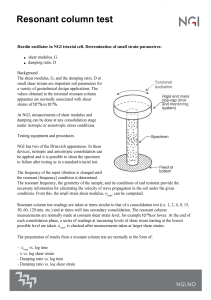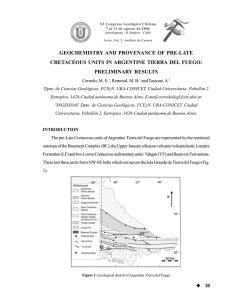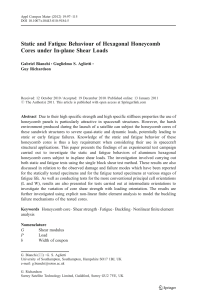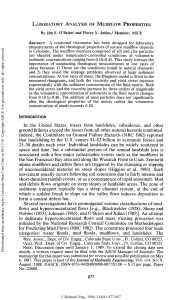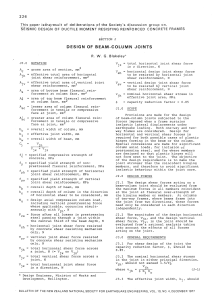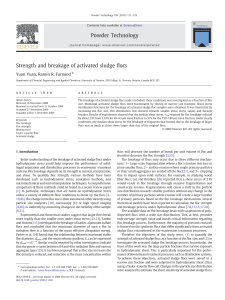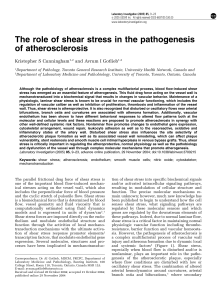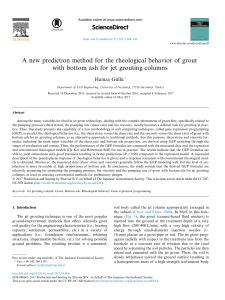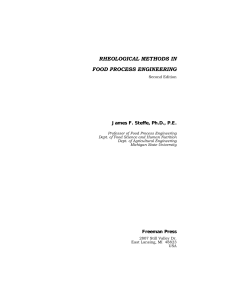Development of "lozenges" in anastomosing shear zone networks in
Anuncio
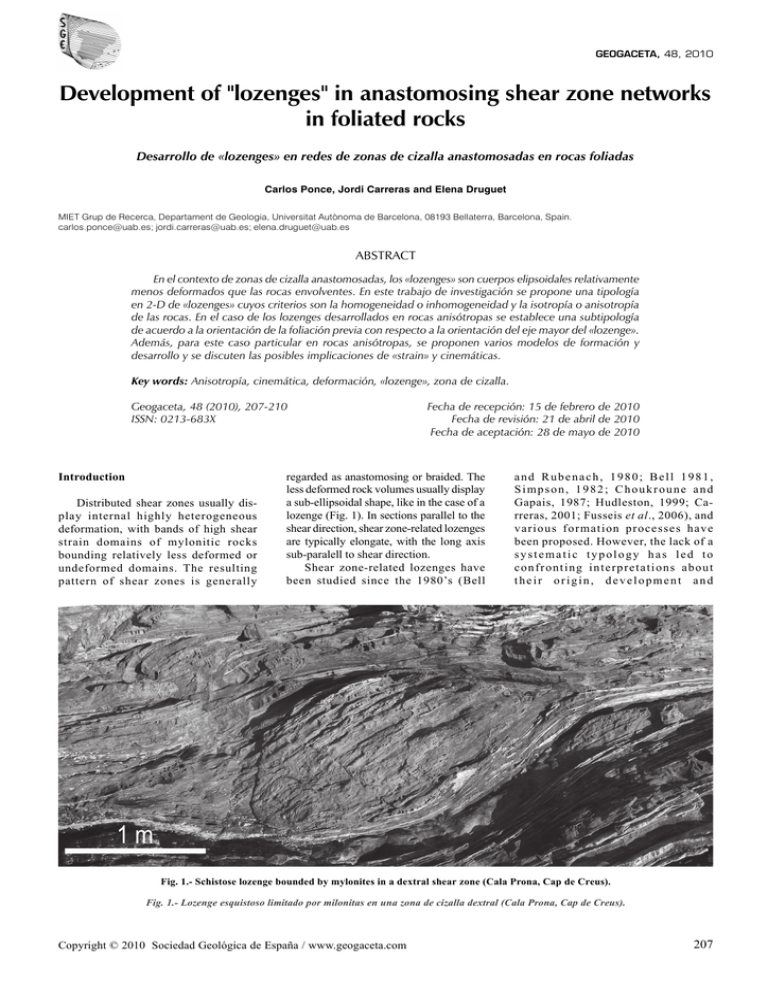
GEOGACETA, 48, 2010 Development of "lozenges" in anastomosing shear zone networks in foliated rocks Desarrollo de «lozenges» en redes de zonas de cizalla anastomosadas en rocas foliadas Carlos Ponce, Jordi Carreras and Elena Druguet MIET Grup de Recerca, Departament de Geologia, Universitat Autònoma de Barcelona, 08193 Bellaterra, Barcelona, Spain. [email protected]; [email protected]; [email protected] ABSTRACT En el contexto de zonas de cizalla anastomosadas, los «lozenges» son cuerpos elipsoidales relativamente menos deformados que las rocas envolventes. En este trabajo de investigación se propone una tipología en 2-D de «lozenges» cuyos criterios son la homogeneidad o inhomogeneidad y la isotropía o anisotropía de las rocas. En el caso de los lozenges desarrollados en rocas anisótropas se establece una subtipología de acuerdo a la orientación de la foliación previa con respecto a la orientación del eje mayor del «lozenge». Además, para este caso particular en rocas anisótropas, se proponen varios modelos de formación y desarrollo y se discuten las posibles implicaciones de «strain» y cinemáticas. Key words: Anisotropía, cinemática, deformación, «lozenge», zona de cizalla. Geogaceta, 48 (2010), 207-210 ISSN: 0213-683X Introduction Distributed shear zones usually display internal highly heterogeneous deformation, with bands of high shear strain domains of mylonitic rocks bounding relatively less deformed or undeformed domains. The resulting pattern of shear zones is generally Fecha de recepción: 15 de febrero de 2010 Fecha de revisión: 21 de abril de 2010 Fecha de aceptación: 28 de mayo de 2010 regarded as anastomosing or braided. The less deformed rock volumes usually display a sub-ellipsoidal shape, like in the case of a lozenge (Fig. 1). In sections parallel to the shear direction, shear zone-related lozenges are typically elongate, with the long axis sub-paralell to shear direction. Shear zone-related lozenges have been studied since the 1980’s (Bell and Rubenach, 1980; Bell 1981, Simpson, 1982; Choukroune and Gapais, 1987; Hudleston, 1999; Carreras, 2001; Fusseis et al., 2006), and various formation processes have been proposed. However, the lack of a systematic typology has led to confronting interpretations about their origin, development and Fig. 1.- Schistose lozenge bounded by mylonites in a dextral shear zone (Cala Prona, Cap de Creus). Fig. 1.- Lozenge esquistoso limitado por milonitas en una zona de cizalla dextral (Cala Prona, Cap de Creus). Copyright © 2010 Sociedad Geológica de España / www.geogaceta.com 207 GEOGACETA, 48, 2010 C. Ponce et al. Fig. 2.- Cala d’Agulles sub-vertical profile. (a) Location map of the zone. Pre-mylonitic fabrics are depicted in grey with dashed lines, and mylonitic bands in black. (b) Detail profile of part of the Cala d’Agulles shear zone array where centimetric to metric-scale lozenges abound. (c) Lozenges developed by intersection of two differently oriented sets of ductile shears. (d) Lozenge developed by the interaction of two sub-parallel ductile shears. (c) and (d) are details shown in (b). Fig. 2.- Sección sub-vertical de Cala d’Agulles. (a) Mapa de situación de la zona. Las fábricas premiloníticas se muestran en gris con líneas discontinuas, y las bandas miloníticas en negro. (b) Perfil de detalle de una parte del conjunto de zonas de cizalla de Cala d’Agulles, donde «lozenges» de escala centimétrica a métrica abundan. (c) «Lozenges» formados por intersección de dos familias de zonas de cizalla con distinta orientación. (d) «Lozenge» formado por la interacción de dos cizallas sub-paralelas. (c) y (d) son detalles mostrados en (b). significance in the context of anastomosing shear zones. Here, we propose a main typology of shear zone-related lozenges with regard to the pre-shearing rock properties. This typology has two end-members: (1) Lozenges in rheologically heterogeneous rocks. Their development is related to the presence of rock bodies that behave more competent than their surrounding media. These are typically developed in shear zones affecting rocks with a marked competence constrast. This is the case of, e.g., a sheared competent dyke in a less competent schistose matrix, the pebbles in a mylonitic conglomerate, or the porphyroclasts in a mylonitic gneiss. (2) Lozenges in homogeneous rocks that arise from the confluence of either two sets of conjugated shears or two curved shears. While the origin of type 1 lozenges does not present much difficulty, type 2 lozenges are at present less understood. For type 2, a subdivision can be made between lozenges in isotropic rocks (type 2a), such in the case of an inhomogeneously deformed granite, and in anisotropic rocks (type 2b), such in the case of lozenges of schist. The present work is focused in the formation and development of lozenges in homogeneous foliated rocks (type 2b, Fig. 1 and Fig. 2). 208 2D typology of lozenges in foliated rocks For the case of lozenges developed in homogeneous anisotropic rocks, a two-dimensional typology has been proposed. This typology, defined in profiles normal to the mean shear plane and parallel to the shear direction, considers two variables: (i) the orientation of the pre-shear foliation with regard to the mean shear plane or the enveloping surface of the mylonitic foliation/with regard to the long axis lozenge, and (ii) the kinematics of the bounding shear zones, that is, shear zones of the same or opposite shear sense (Fig. 3). This typology does not take into account if the different angular relationships between the previous foliation and the bounding shears are original features or achieved during shear progression as the result of strain affecting the shape of the lozenge. For the sake of simplicity, the typology considers that the bounding shear zones make an acute angle to the lozenge long axis and that each individual shear zone satisfies the simple shear model (ωk=1). In any case, the final structure of a lozenge is independent of the bulk deformation, whose kinematic vorticity number is variable (0< ωk<1). Different internal structures of lozenges arise by changing the bounding kinematics and/or the relative orientation of the pre-existing foliation with regard to the bulk extension or shear direction (Fig. 3). This typology can be extended by varying the initial angle of the pre-existing foliation and also the angle between shear sets. Development models In the wide context of brittle and ductile deformations, and in the most simple case where anisotropy is not taken into account, there are two basic mechanisms for the development of anastomosing shear zone networks and associated lozenge-shaped rock bodies. First, the intersection of conjugate shears (Choukroune and Gapais, 1987; Hudleston, 1999). A particular case is that of lozenges arisen from conjugate R and R’-shears in simple shear flow. Second, throughout the interaction of sub-parallel shears across restraining oversteps (Walsh et al., 1999). Particular and common cases of this second type are (i) the linking of en-échelon Rshears throughout P-shears (Tchalenko, 1970; Swanson, 2005), and (ii) the strike-slip duplexes (Woodcock and Fischer, 1986). A more complex scenario arises if the role of anisotropy is taken into account to explain the development of lozenges such the ones observed in our Geología Estructural y Tectónica Development of “lozenges” in anastomosing shear zone networks in foliated rocks GEOGACETA, 48, 2010 Fig. 3.- Lozenges bounded by shear zones of the same shear sense (a and c) or by conjugate shears (b and d). In a and b, the pre-existing foliation is at a low angle to the bulk extension, while in c and d this angle is higher. For all situations light gray arrows indicate firsts active shears, while dark ones indicate second set. Fig. 3.- «Lozenges» rodeados por zonas de cizalla de igual sentido de cizalla (a y c) o por cizallas conjugadas (b y d). En a y b, la foliación previa forma un ángulo bajo con la dirección de extensión global, mientras que en c y d el ángulo es mayor. Para todas la situaciones las flechas en gris claro indican las primeras cizallas activas, mientras que las oscuras indican la segunda família de cizallas. field area. This aspect has been far less investigated (Williams and Price, 1990; Carreras, 2001). Detail mapping and analysis of structures in the field area (Fig. 2) allows us to ascertain four processes that may lead to the development of the lozenges (Fig. 4). The first two are analogue to the ones described before for isotropic rocks. (1) Intersection of two sets of differently oriented shear zones (Fig. 2C and 4A). The presence of conjugate shear systems (Williams and Price, 1990) can give rise to the typical millipede structures (Bell, 1981). (2) Interaction and linkage of two overstepping Riedel shears throughout their curving propagation (Fig. 2D and 4B). (3) Linkage of individual shear zones of a dominant set throughout antithetic shears that propagate subparallel to the pre-existing foliation (Fig. 4C, Lister and Williams, 1979; Carreras, 2001). (4) Development of extensional crenulation cleavages or shear bands o n an already well developed Fig. 4.- Basic models for the development of lozenges in anastomosing shear zones in foliated rocks. Formation of lozenges by intersection of conjugate shears (a), by interaction and coalescence of two sub-parallel shears (b), by linkage of parallel shears throughout antithetic shears propagating sub-parallel to the pre-existing foliation (c) and by development of shear bands on an already well developed heterogeneous mylonitic foliation (d). Fig. 4.- Modelos básicos para el desarrollo de «lozenges» en zonas de cizalla anastomosadas en rocas foliadas. Formación de «lozenges» por intersección de cizallas conjugadas (a), por interacción y coalescencia de dos cizallas sub-paralelas (b), por unión de cizallas paralelas mediante cizallas antitéticas que se propagan sub-paralelamente a la foliación preexistente (c), y por desarrollo de «shear bands» sobre una foliación milonítica heterogénea (d). Sociedad Geológica de España 209 GEOGACETA, 48, 2010 heterogeneous mylonitic fabric (Fig. 4D). It is suggested that in natural shear zones, lozenges may develop by a combination of any of the here described four processes. The Cala d’Agulles case study, shows the relevance of the orientation of the previous foliation in controlling the prevalent mechanism of lozenge formation. At the northwesternmost part of the profile, where foliation dips to the NNW, lozenges are mainly formed by type 2 and 3 mechanism (Fig. 2D); while at the southeasternmost part, where foliation is almost vertical, millipedelike lozenges formed by intersection of two sets of conjugate shear zones (type 1) are present (Fig. 2C). As the bulk kinematics is the same along the whole profile (dextral), the foliation orientation must play an important role on the formation mechanism. This fact was already experimentally demonstrated by Williams and Price (1990). C. Ponce et al. rheological and kinematical variables: the nature of the host rocks (isotropic / anisotropic, homogeneous / inhomogeneous), the angular relationships between the pre-existing layering / foliation and the kinematics axes, and the bulk kinematic regime. A typology including four basic models is presented to explain the origin and development of lozenges in homogeneous anisotropic rocks. Our field observations indicate that, in foliated rocks, the prevailing acting mechanism does not depend so much on the bulk kinematics (degree of noncoaxiality) but on the angular relationship between the pre- existing foliation and the bulk kinematic axes. The fact that there is a great variety of initial orientations, propagation modes and coalescence types implies that the final geometry is not univocally related neither to strain type (oblate/prolate) nor to the degree of non-coaxiality. The complete understanding of lozenges requires further investigation in 3D. Acknowledgements Conclusions The formation of shear zonerelated lozenges is governed by 210 This work was funded by the Spanish Ministry of Education and Science (Project CGL2007-66857-C02-01). References Bell, T.H. (1981). Tectonophysics 75, 273-296. Bell, T.H and Rubenach, M.J. (1980). Tectonophysics 68, T9-T15. Carreras, J. (2001). Journal of Structural Geology 23, 1457-1486. Choukroune, P. and Gapais, D. (1987). Journal of Structural Geology 5, 411418. Fusseis, F., Handy, M.R. and Schrank, C. (2006). Journal of Structural Geology 28, 1228-1243. Hudleston, P. (1999). Journal of Structural Geology 21, 923-932. Lister, G. and Williams, P. (1979). Journal of Structural Geology, 1, 283-297. Simpson, C. (1982). Journal of Structural Geology, 5, 61-72. Swanson, M.T. (2005). Journal of Structural Geology 27, 871-887. Tchalenko, J.S. (1970). Geological Society of America Bulletin, 81, 1625-1640. Walsh, J.J., Watterson, J., Bailey, W.R. and Childs, C. (1999). Journal of Structural Geology, 21, 1019–1026. Williams, P.F. and Price, G.P. (1990). Journal of Structural Geology 12, 145–164. Woodcock, N.H. and Fischer, M.(1986). Journal of Structural Geology, 8, 725– 735. Geología Estructural y Tectónica
